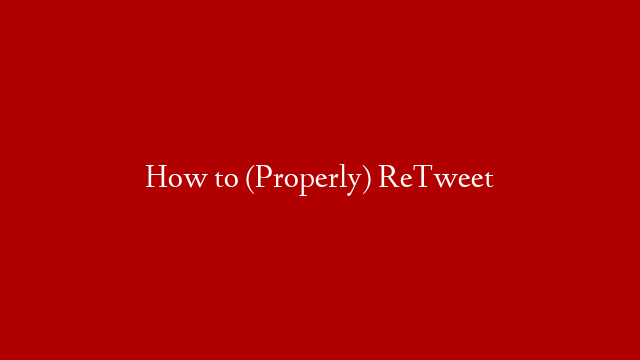One of the best features of Twitter is the ability to share what others say via the ReTweet feature.
ReTweeting is an integral part of the Twitter experience – but it must be handled appropriately. Below are some of the most common questions I receive about ReTweets and some advice on how to handle them.
What is a ReTweet?
Repeating a Twitter message, or Tweet, from another user. For example, if someone shares a thought or link that you believe will be useful to others in your immediate network, you can instantly share it with them.
The symbol “RT” begins a ReTweet. It is immediately followed by the handle of the person who wrote it first.
Here is an example:
The original Tweet from @person:
Terrific resource for authors on book marketing! URL.com
Here is the message, ReTweeted:
RT @person Terrific resource for authors on book marketing! URL.com
How do I ReTweet a message?
Twitter’s main site and third-party applications like TweetDeck offer one-click sharing. All you do is click the ReTweet button next to the message you want to share and the program automatically shares it with your network. You can also click the TweetMeme green button within blog posts to share them.
Sometimes, though, the ReTweet feature doesn’t work and you will need to do it manually. When this happens, you should copy and paste the original message into the status bar and add the “RT” and handle of the person who first shared the thought.
Can I Add My Own Thoughts to the ReTweeted Message?
Yes. Add your own thoughts before the ReTweeted message. That way, readers will be able to differentiate between your thoughts and the original Tweet.
Here is an example using the message above:
Great site! RT @person Terrific resource for authors on book marketing! URL.com
You should never put your own thoughts after the ReTweeted message. Why? Because in the Twitterverse, that makes it appear as though the original message author had that thought, not yourself.
Here is an example of a bad ReTweet:
RT @person Terrific resource for authors on book marketing! URL.com Yeah, right.
By adding the “Yeah, right,” thought to the end of the Tweet, it changes the meaning of the original message and attributes that meaning to the original author.
Can I Reword a ReTweet That Is Longer Than 140 Characters?
Yes – within reason. Here are some tips on how to do it right:
Never take a Tweet out of context. Twitter users are vigilant about their information and any user who takes their messages out of context will be blocked and booed. Some users will even send messages out to their networks, asking others to block users who have misquoted them. What does it mean to take a Twitter message out of context? If you reword a Tweet to insert your own opinion, or delete words to give the message a whole new meaning, you are committing a major Twitter faux pas.
Never change the link provided by the original user. In my Twitter lifetime, I have experienced a few unscrupulous marketers who replaced my links with some of their own. That is a big no-no and will get you hammered for it.
Always attribute Tweets to the correct person. Never take a thought from one person’s message stream and attribute it to someone else. This is the same as misquoting in journalism. Twitter users are forgiving if you do it manually and forget a letter in a handle. If this happens, just ReTweet the message again with the correct handle.
Never make up a message and attribute it to someone else. I’ve experienced this only once; others many times. A new follower to my network wrote a message that made little sense and attributed it to me via ReTweet. The message was so far from anything I write, it could not have even come from a poorly- reworded Tweet. Fortunately, I have a devoted Twitter network – and a branded presence on the site – so most knew it did not originate with me. However, I made certain to let others know it wasn’t me and blocked the user.
Use standard online abbreviations to make ReTweeted messages fit 140 characters. The bane of RTs is keeping them within Twitter’s 140 character limit. You can easily make messages fit by using acronyms, like the letter “R” for “Are,” or the letter “U” for “you.” Instead of spelling out state names, you can use the two-letter postal abbreviations. Third-party applications like TweetDeck automatically readjust messages to fit the character limit.



![E-mail marketing 2020 | Automated mails in mailchimp[Part-9] | (in Hindi)](https://www.recue.com/wp-content/uploads/2022/09/Email-marketing-2020--Automated-mails-in-mailchimpPart9--in-Hindi.png)